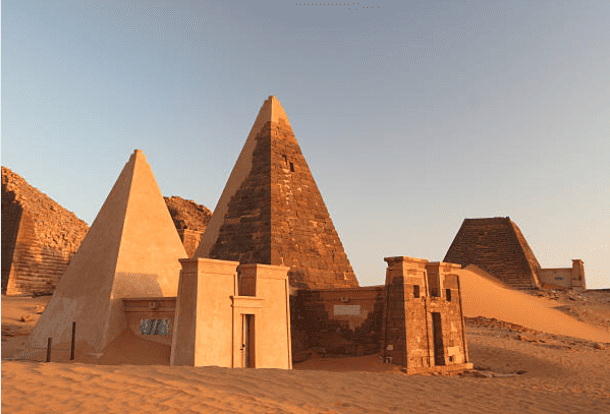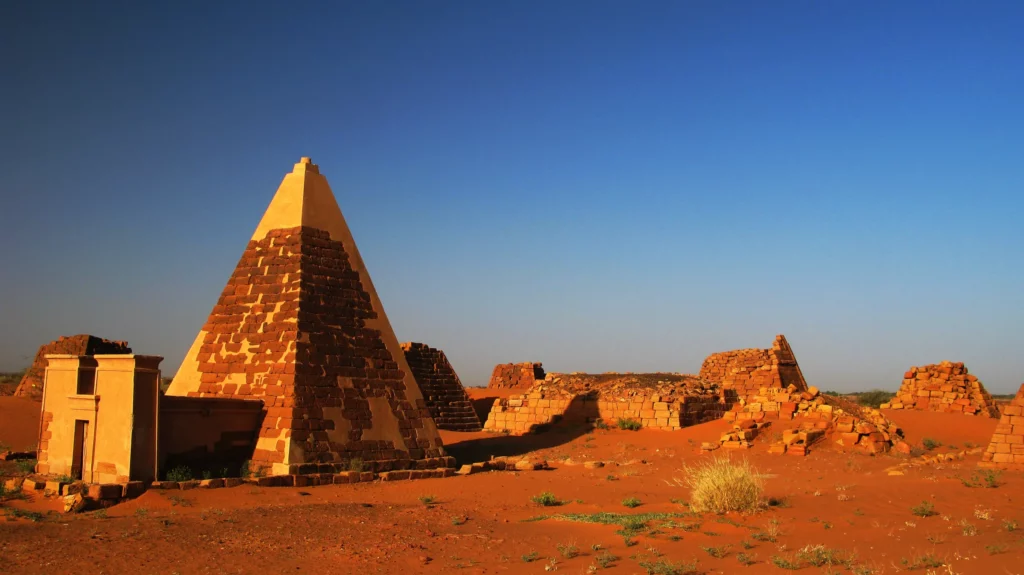Nubian Pyramids: The Ancient Sudanese Royal Tombs No One Seems to Know About

Updated On: November 09, 2023 by Noha Basiouny
Just like how we think of India when it comes to cultural diversity, France and Italy when referring to the most mouth-watering cuisines, China when we spot even a panda keyring and Silicon Valley when someone mentions social media, Egypt is synonymous with pyramids.
We would not go as far as saying that ancient Egyptians invented architecture for ancient Greeks already did millennia before Egyptian pyramids came into existence. Yet, the pharaohs are credited for developing the structure of pyramids, which, by the way, took decades. The Great Pyramid of Giza, as it represents an incredible level of engineering cleverness and accuracy, was the result of a long journey of architectural evolution, which we have already demonstrated in a previous story.

Having said that, ancient Egypt is not the only civilisation that built pyramids, but many others did as well. Many people know about the amazing Mesoamerican pyramids in Mexico which were built between 1000 BC and the 15th century. Yet, not many people know that Sudan, then called Nubia, too, built pyramids in ancient times.
In this article, we are going to explore the Nubian pyramids, when they were built, what purpose they were built for and in what way they were influenced by yet different from Egyptian pyramids. So bring along a cup of coffee, and let’s hop into it.
Ancient Nubia
Even though it did not really receive as much recognition as other ancient civilisations did, ancient Nubia was one of the earliest and most distinct civilisations in the world. It indeed requires encyclopaedias, not just a 6-minute read article, to talk about. But since we are more concerned with the Nubian pyramids here, we are just going to give you a quick overview of this civilisation.
Nubia was, in fact, the name of the region that stretched from southern Egypt to modern-day Khartoum, the capital of Sudan. The northern area was called Lower Nubia and the southern region was, yes, Upper Nubia and both were called so thanks to the River Nile flowing from the highlands of Africa down toward the Mediterranean.
Nubia was then the homeland to the three Kingdoms of Kush with each lasting for a few centuries and having a different capital. The first kingdom, for example, started in 2500 BC and lasted until 1500 BC and had a capital city called Kerma located in Upper Nubia.
The second kingdom was between 1000 and 300 BC, with Napata being its capital yet this was located in Lower Nubia. The third kingdom, and by far the golden age of the Kush Empire, started in 300 BC and ended 600 years later in 300 AD. The capital was Meroe, which was also in Lower Nubia.
The relationship between Egypt and Nubia could be described as long-lasting, influential and pretty much complicated. For the ancient times at least, there had always been ongoing wars between the two empires, each wanting to take over the other.
We can fairly say that throughout history, Egypt had always been concerned with Nubia and often considered it to be a part of it. In fact, Nubia was kind of on the to-do list of every new pharaoh. They had to either keep it as an Egyptian territory or reclaim it as one.
Nubia, on the other hand, was mostly fighting back to maintain or regain independence from Egypt. Yet, on some occasions, Nubia was powerful, which somewhat matched some of Egypt’s weakest periods so it attempted to conquer Egypt. On one of these occasions, precisely in 747 BC, Nubia succeeded in dominating Upper Egypt. That occurred during one of the most chaotic times in ancient Egypt, a period known as the Third Intermediate Period.
The Kushites, who ruled Nubia and were often referred to as the black pharaohs, dominated Upper Egypt for 88 years. During this long period, they were so heavily influenced by Egyptian culture that they worshipped Egyptian gods and followed Egyptian rituals. It was about this time, too, when the Kushites started building pyramids.
Nubian Pyramids
The Kushites built over 250 pyramids, which is more than double the number of pyramids identified in Egypt so far—that is 118. Some Nubian pyramids are still very well preserved, while others were partially or completely by Europeans who were looking for treasures there in the 19th century. Despite that, Nubian pyramids, whether destroyed or intact, were declared UNESCO World Heritage Sites.
Interestingly, by the time the Kushites started building pyramids, ancient Egyptians had already abandoned this activity long ago and replaced it with digging tombs deep in the ground in the Valley of the Kings and the Valley of the Queens in Thebes, modern-day Luxor. But like ancient Egyptians, the Kushites built pyramids for the exact same purpose, to use them as giant tombs for their royals and elite.
The pyramid building activity in Nubia started during the second Kingdom of Kush, which lasted between 1000 and 300 BC. At the time, the capital was Napata which was located some 1.5 kilometres east of the modern-day city of Karima, which itself is 400 kilometres north of Khartoum. Consequently, the first pyramids were built in Napata but in three different sites, or say royal cemeteries, where Kushite kings and queens were buried.
The first and most famous of these Napatan sites is called El-Kurru. Since this site was already a royal cemetery, the Kushites decided to continue burying their kings and queens there but instead replaced the tombs with pyramids.
Only 10 kilometres away from El Kurru, the second site, Nuri, is located. Nuri was by far the largest royal necropolis in Nubia. The third site, which is also not too far away, is called Jebel Barkal and has around nine pyramids.
When the capital of the Kingdom of Kush moved from Napata to Meroe, now 200 kilometres northeast of Khartoum, the pyramid-building activity also moved there. Meroe is actually where most of the Nubian pyramids are concentrated, as the city hosts over 200 pyramids as well as other tombs for Kushite kings and queens.
Differences
Although they were influenced by ancient Egyptians, the Kushites did already add their very special touch that made their pyramids look different and pretty distinguished from their Egyptian counterparts. It is like they took the engineering concepts and played around with them to build unique structures.
One difference between Nubian and Egyptian pyramids anyone can notice is the size. Nubian pyramids are much smaller than the Egyptian ones. The pyramids of Meroe, for instance, have narrow bases and range in height between six and 30 metres. The largest Nubian pyramid, that one thought to belong to Queen Amanishakheto, is 30 metres tall, while the Pyramid of Menkaure, the smallest of the Great Three in Giza, already measures 65 metres while the Pyramid of Khufu is 139 metres tall.
This could actually be why the Kushites built more pyramids than the Egyptians. Such relatively small structures would not usually take a long time to complete. Large Nubian pyramids, for instance, were estimated to take a little over a year to complete. On the other hand, the construction of the Great Pyramid of Giza took over 20 years.
Nubian pyramids are also very steep, with a slope angle of 70° compared to that of Egyptian pyramids, which ranges between 40° and 50°. Besides, most Nubian pyramids, like the Pyramid of Djoser, are stepped ones, while ancient Egyptians abandoned this structure ever since they managed to develop true pyramids with smooth edges.
Another difference is that the Kushites never used limestone to build their pyramids. Instead, they used mud bricks, granite and sandstone. On the other hand, limestone was a principal component in the Egyptian pyramids.
Structure
The internal structure of the Nubian pyramids was also pretty interesting and quite different. Unlike many Egyptian pyramids, the Nubian pyramids never had burial chambers inside of them. Instead, the Kushites dug the burial chambers in the ground, connected them to the surface through a staircase and buried the entrance so the burial chambers could not be reached.
There could be either one or two burial chambers attached to one another. In the case of two, the first chamber, called the antechamber, was decorated with paintings of the deceased royal with the gods and columns of hieroglyphic texts taken from religious books to guide them in the afterlife. The second chamber was where the mummified body of the deceased rested in wooden coffins which, like Egyptian royal coffins, were filled with treasures.
Then using stones and mud bricks, the Kushites built pyramids above the ground primarily to serve as solid tombstones. As we mentioned, their pyramids, unlike many Egyptian pyramids, never enclosed any chambers but were instead completely solid. The outer stones just enclosed debris and remains.
Yet, Nubian pyramids had an extra structure and that was the offering chapel that was attached to the base of the pyramid. This was a small room, which you may think of as a pantry, where the Kushites added everything they thought the deceased might need in the afterlife. This included food, tools, clothes, jewellery and many other things.
The walls of the offering chapel were also decorated with carvings and reliefs of the deceased. On one wall, for example, the king or queen are shown during their lifetimes. On the opposite wall, they are shown being welcomed by the gods.
Destruction
European excavation of the Nubian pyramids started in the early 19th century. For some reason, mostly political, it stopped for a long time but was resumed again in the early 20th century when serious exploration work was done.
Like Egyptian royal tombs, archaeologists found most Nubian pyramids empty. No treasures were found in the tombs nor in the offering chapels. Even the mummies were stolen in antiquity. But what was even more tragic was the destruction of many Nubian pyramids by the Italian treasure hunter, or should we say thief, Giuseppe Ferlini.
Born in Bologna, Italy, in 1797, Giuseppe Ferlini came to Egypt in the early 19th century and joined the Egyptian army on an expedition to conquer Sudan in 1820. He stayed in Sudan for a long time. But after he met some Albanian merchant, both men decided to go treasure hunting in the desert.
Determined to go back home with loads of treasures, Ferlini somehow succeeded in obtaining permission to do excavations on the pyramids of Meroe in 1834. He had heard from the locals that the pyramids hid gold and silver jewellery, so he went crazy to find them.
He did not know where to start, so he wreaked havoc on the pyramids he came across, partially or even completely demolishing them. It was even reported he used explosive materials to bring down the pyramids.
One of the pyramids he flattened was actually the largest in the entire necropolis of Meroe, which was thought to belong to Queen Amanishakheto. Ferlini did find high-quality gold and silver jewellery there, which he stole and took back to Europe. In total, Ferlini is responsible for demolishing more than 40 pyramids.
Though not many people, unfortunately, know about them, the Nubian pyramids are a terrific representation of the prosperity and brilliance of the Kush Empire, a sweet reflection on the double-sided influence between Nubia and Egypt and an indication of a great civilisation that is worth every recognition and appreciation.






